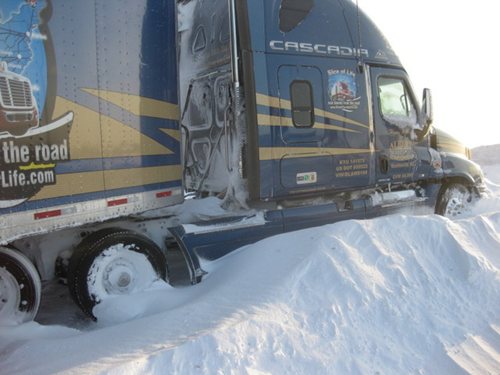
Snow has already fallen in some parts of the country. With all of this comes icy road and bridge conditions. This season brings along a host of challenges such as; black ice, blinding snow, and holiday traffic.
Let’s start with black ice as this is deadly. Black ice can sneak up on you quickly especially if you are driving in rain and the temperature is dropping. Mirrors are one of the first items within a drivers reach to indicate the potential for icy roadways. I like to reach out and feel the front sides of my mirrors on a regular basis to see if ice is forming. Another indication is when you notice the absence of road spray off of your tires or the tires of other vehicles passing you.
If you do find yourself on black ice, first gently release your foot off of the accelerator pedal, next ease into your brake pedal, to reduce yourself to a safe speed. Do not and I mean do not use your engine brakes in this situation, because this is only applying breaking effort to four-wheel positions at the most. It is important to not make any sudden or erratic moves while on ice as it could put you into a skid and total loss of vehicle control. If conditions warrant get off of the roadway and find a safe place to park.
Blinding snow has its own series of challenges. The combination of slippery road conditions and lack of visibility can lead to a catastrophe. The first step to dealing with this condition is to never drive faster than the distance you can see to safely bring the vehicle to a stop. Do not count on being able to see the tail lights of the vehicle ahead of you. Today’s LED taillights do not create enough heat to melt off the snow increasing the possibility of rendering them ineffective for detecting a vehicle in front of you.
Heated mirrors may take care of your problems with seeing behind you but the windshield requires additional tactics. Many times, you can get into a condition where the defrosters are melting the snow on the windshield causing the windshield wipers to become iced up and ineffective. Iced over windshield wipers require frequent stops to clear them of ice. Sometimes putting your sun visor down will hold more of your defroster heat on the windshield preventing iced up windshield wiper blades. My preferred tacit that I learned from a driver years ago is to freeze the windshield. To prepare for this situation I will find a safe place to park and turn on my defrosters to the coldest temperature possible. Once the windshield is completely frozen I get out my ice scraper to clear the windshield of all ice, after this is done I turn my heater control to the floor with just enough warmth to be comfortable while wearing a coat. With the windshield frozen the snow will not stick to the windshield allowing snow to simply blow off. This only works when it is very cold, and the windshield stays cool enough to not melt the snowflakes.
Finally, there is traffic to deal with and this time of year holiday travelers. Give everyone extra distance and have patience. The easiest way to sum up how to deal with other vehicles that you have no control over is to always assume they may not take the right action during winter conditions. On a second thought assuming vehicles around you may make the wrong maneuver is a good polity regardless of the weather conditions. Try to always keep yourself from being boxed in without a way out of a potentially disastrous situation.
Finally, what inspired this blog to be written was a video I saw on Facebook of a massive pileup on a snowy interstate highway. I watched in horror as vehicle after vehicle entered the pileup with nowhere to go other than to become part of the pileup. It seemed to me that most of this could have been prevented had these drivers known that traffic was stopped ahead or if driving much slower for conditions. This is where old tools that or seldom used such as the CB radio could have alerted other drivers to the hazard ahead. In fact, this form of communication could have possibly prevented the crash to start with.
The simple warning that the road is icy on the other side of the hill or that there was an accident ahead could have prevented the catastrophic pile up that ensued. Of course, this would require three things, first a vehicle equipped with a CB, to someone to broadcast the warning across the CB, and finally for the vehicle to have a CB and to be turned on to hear the warning. This is the ideal use of the citizen's band radio. Today it seems that the radio is fairly quiet, most of the trash talk is gone, making it the ideal time for its use as a safety tool. In the past, people would flash their headlights, wave their arm out the window to warn oncoming traffic there is a hazard ahead.
In the end, let’s all do our part to have a safe winter driving season.